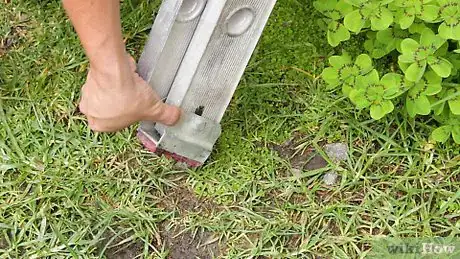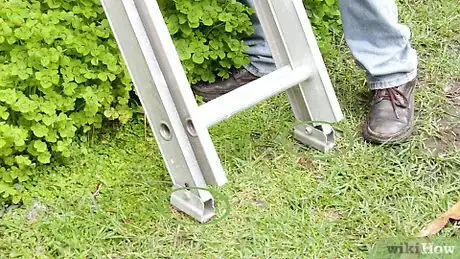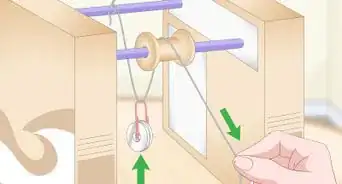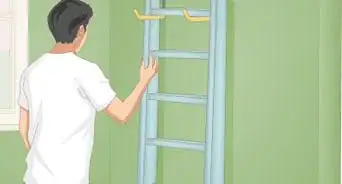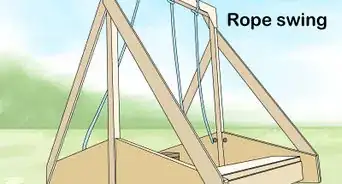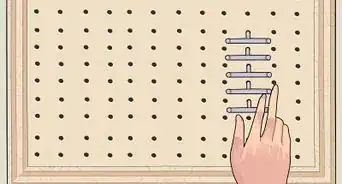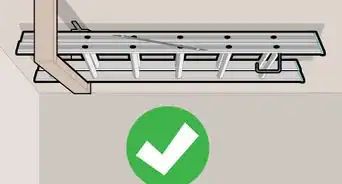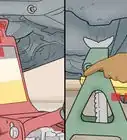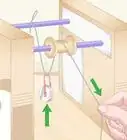This article was co-authored by Allen Lee. Allen Lee is a Home Improvement Specialist and the Owner of Honest Lee Handyman Services, a licensed and insured handyman business servicing Sacramento, California, and surrounding areas. Working with homeowners and businesses to get their small repairs done in a timely and efficient manner, Honest Lee Handyman Services provides gutter and dryer vent cleaning along with fixture, fence, drywall, and toilet repairs.
There are 7 references cited in this article, which can be found at the bottom of the page.
wikiHow marks an article as reader-approved once it receives enough positive feedback. In this case, 87% of readers who voted found the article helpful, earning it our reader-approved status.
This article has been viewed 225,944 times.
Silly as it may sound, ladder-related injuries are among the most common easily preventable accidents. Roughly 250,000 Americans were injured as a result of ladder accidents in 2012 alone.[1] Most of these injuries (97%) occurred at home, not construction sites. Extension ladders, which can be used to reach great heights, played a part in some of these worst of these accidents. Though not especially challenging to use, this article will teach you how to use an extension ladder while keeping yourself safe.
Steps
Getting to Know Extension Ladders
-
1Familiarize yourself with the parts of the extension ladder. There are a few basic parts of the extension ladder that you should be familiar with before you attempt to use it.[2] Here are the most important:
- The safety shoe or foot of the ladder consists of the pads that are designed to be in contact with the ground when the ladder is in use. These typically will swivel or rotate slightly in order to be make better contact with the surface the ladder is on.
- The fly section is the portion of the extension ladder that will be extended upward. This is the portion that you will climb as you get closer to the top. Additionally, it should be noted that some extension ladders have a two-part fly (and three primary ladder components in total).
- The base section is the portion of the extension ladder that will remain in place. When you begin to climb the ladder, you will start out on the rungs of this section.
- The rung lock is attached to the fly and is used to keep the fly in place by fitting over the top of a rung of the base or fly section underneath. It will essentially act as a bracket, and the fly will not be able to slide down after weight if put on it.
- The rope and pulley are used to extend the largest of extension ladders. Smaller ladders do not have this component, but larger ones are essentially unusable if this is broken.
-
2Understand why extension ladders are considered dangerous. Serious injuries resulting from the use (or misuse) of extension ladders are so common that they have developed a bit of a reputation. Knowing how they earned that reputation--and how those accidents could have been prevented-- can help you stay safe.
- Extension ladders typically only have two points of contact with the ground. Some varieties of smaller ladders fold out to create four separate points of contact with the ground. Extension ladders typically have nothing other than the "feet" or "shoes" on the two side rails. Consequently, they can be a bit unstable.
- Extension ladders are among the tallest available in retail sales outlets. It is not merely that their height makes for longer falls (though that is true as well). Instead, the height only accentuates the preexisting instability issues. Think of the ladder as a lever. When you climb the ladder, the weight is actually moved closer to the end of the lever.
- People commonly misuse extension ladders. Because of their instability issues, there are certain precautions that must be taken. First, two people must be involved in the use of the ladder. When one person climbs, another must be available to "foot" the ladder (hold it in place). Secondly, the ladder cannot be used a vertical or near-vertical angles. Instead, they must bed tilted or leaned on to another object for support as a person climbs to the top (more on this in a moment). This will minimize the "leverage" issue previously noted.
Advertisement -
3Know what your ladder is capable of handling. Each ladder is capable of bearing a different quantity of weight, and you must know how much yours can handle before you you use it. There are a number of ladder classification systems in use--several of which use very similar terminology to mean rather different things--and so it is not practical to list them here. Regardless of type, your ladder should state directly on it (at least when it is new) how much weight it can bear. Do not ever exceed that limit.[3] [4]
Setting up and Using the Ladder
-
1Inspect the ladder before use. Damage to the rungs, the rung lock, or pulley could make it dangerous or impractical to use an extension ladder. Look the ladder over carefully before you begin use.
-
2Move the ladder. It should be locked in place using the rung lock or other safety feature. If the fly slides as you are moving the ladder, fingers and hands could be pinched or broken as they get caught between the fly and the base or between the rungs of the two sections.
-
3Begin to position the ladder. Move the ladder into place (without yet extending it) and set it down on the shoe or foot that is attached to the base. For most extension ladders the fly should be on top of the base--that is, not only should it extend higher, but should on the outer/climbable side.[5]
- Understand that in order to obtain the proper climbing angle, the base of the ladder should be 1/4 of the height of the extended ladder away from the building.[6] For example, if the working height of the extended ladder is 12 feet (3.66 m), the base of the ladder should be 3 feet (.914 m) away from structure.
-
4Raise the fly section. If your ladder uses a pulley, simply pull on the rope to extend the ladder. If not, push the fly up manually.
- Make sure that the base of the ladder is continuously footed (with at least one person holding both rails of the base continuously) during the raising process.
- Observe extreme caution if extending the ladder in windy conditions.
- If working on or examining a roof, extend the ladder to about 3 feet (.914 m) above the working height.[7]
-
5Lock in the fly in place with the rung locks. This will ensure that the fly will not slide closed while climbing the ladder.
-
6Lower the ladder carefully to the structure. making sure that you continue to foot the ladder so that the base of the ladder does not kick out. Make sure that both sides of the ladder have good contact with the structure. If one edge of the ladder is not touching the structure, it is not safe and no one should climb the ladder.
-
7Use the ladder. Climb the ladder one rung at a time. Maintain a hold with both hands as you move your feet up each rung. Do not carry other items in your hands at this time. If you need small tools with you, place them in a tool belt that you can carry around your waist.
- If you are fully extending the ladder, you should use a tie down or bungee cord to secure the ladder in place.[8] Wrap it around the top part of the ladder, and secure it to the building.
Expert Q&A
Did you know you can get expert answers for this article?
Unlock expert answers by supporting wikiHow
-
QuestionWhat is the correct way to use an extension ladder?
 Allen LeeAllen Lee is a Home Improvement Specialist and the Owner of Honest Lee Handyman Services, a licensed and insured handyman business servicing Sacramento, California, and surrounding areas. Working with homeowners and businesses to get their small repairs done in a timely and efficient manner, Honest Lee Handyman Services provides gutter and dryer vent cleaning along with fixture, fence, drywall, and toilet repairs.
Allen LeeAllen Lee is a Home Improvement Specialist and the Owner of Honest Lee Handyman Services, a licensed and insured handyman business servicing Sacramento, California, and surrounding areas. Working with homeowners and businesses to get their small repairs done in a timely and efficient manner, Honest Lee Handyman Services provides gutter and dryer vent cleaning along with fixture, fence, drywall, and toilet repairs.
Home Improvement Specialist
Warnings
- Before raising any ladder, make sure that there are no overhead obstructions. Watch out for overhead electric wires, and do not lift or raise a ladder anywhere near them.⧼thumbs_response⧽
- Make sure you wear proper clothing when using a ladder. Do not work with a ladder if you have bare feet.⧼thumbs_response⧽
- Aluminum ladders should not be used near electrical wires because there is a higher risk of electrocution. Instead, use a fiberglass ladder.⧼thumbs_response⧽
- When lifting the ladder, make sure that proper lift techniques are employed. Lifting or raising a ladder incorrectly could lead to injury.⧼thumbs_response⧽
References
- ↑ http://www.popularmechanics.com/home/skills/dont-be-an-idiiot-how-to-use-any-kind-of-ladder-safely-16123359
- ↑ http://www.americanladderinstitute.org/?page=ExtensionLadder
- ↑ https://engineering.purdue.edu/AAE/InfoFor/Safety/laddersafety
- ↑ https://www.ceiwc.com/i-am-an-employer/newsletters/fall2010/preventing-falls-from-extension-ladders-article-and-safety-tip-sheet.pdf
- ↑ http://www.americanladderinstitute.org/?page=ExtensionLadder
- ↑ Allen Lee. Home Improvement Specialist. Expert Interview. 10 July 2020.
- ↑ http://www.nachi.org/accessing-roof-part5-50.htm
- ↑ Allen Lee. Home Improvement Specialist. Expert Interview. 10 July 2020.
- Videos provided by Robin Riley
About This Article
Using an extension ladder safely can protect you from accidents at home or on site. Make sure the rung lock is on whenever you’re moving the ladder to avoid getting your hands caught between the ladders. Always place it with the textured feet on the ground to give it extra grip. To get the right angle, position the base of the ladder ¼ of its extended height away from the building. For example, if you’re extending it to 12 feet, position the base 3 feet away. Lift the fly section of the ladder to the height you want and secure the rung locks. Always have someone else holding the bottom when you’re climbing the ladder just in case it slips. For more tips from our Construction co-author, including how to secure the top of your ladder to a building, read on.
